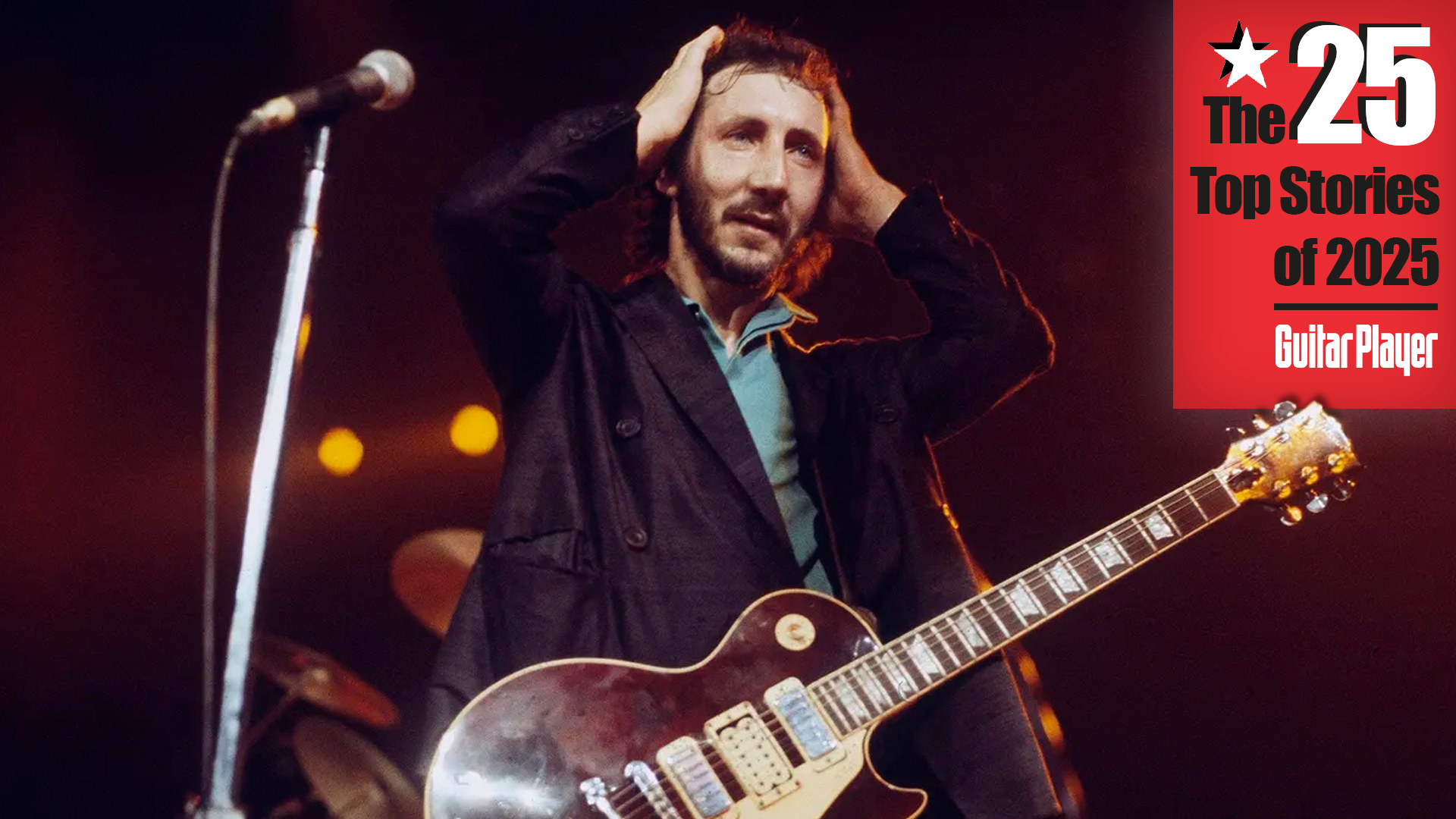Broaden Your Sweep-Picking Palette and Expand Your Melodic Vocabulary
Master one of the most ambitious technical endeavors a guitarist can pursue.

It takes considerable patience to learn how to perform sweep arpeggios with fluidity, keeping the notes separated so they don’t ring together and sound like a lazily strummed chord. Once you have the technique down, however, you can burn through massive six-string sweeps at breathtaking speeds.
But what then? Employing Yngwie-sized roller-coaster sweeps in your solos may sound impressive, but, if overused, it can grow tiresome for your listeners. In this lesson, we’ll give you some helpful tips on how to vary your application of the sweep-picking technique and broaden your phrasing palette to keep things interesting. We’ll also illustrate each step with plenty of helpful musical examples.
Rhythmic Variation
One of the many musical ruts sweep-pickers fall into is using a one-size-fits all rhythmic phrasing, with very little variation within a lick or run. This is usually a practical consideration – rhythmic interest is often disregarded in favor of speed, and it can be quite difficult to negotiate rhythmic changes mid-sweep. But changing up the rhythmic phrasing in a sweep pattern is an effective and fairly simple way to not only make your sweep patterns sound more interesting but also make you a more versatile lead player.
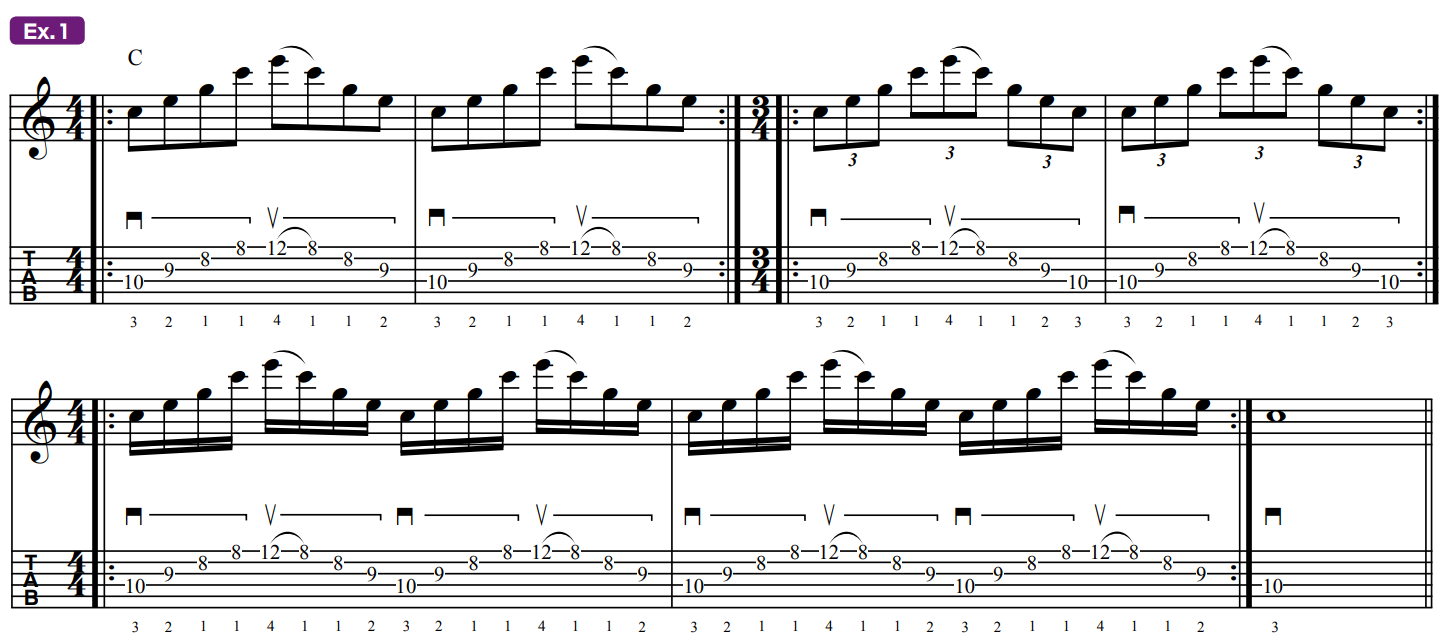
As is always the case when sweep-picking, the key to making the notes sound melodic, and not blurred together like a strummed chord, is to “get off” each note with the fret hand right after it is picked, so that it doesn’t ring, or “bleed,” into the next note. You needn’t let go of the string entirely, but loosen your grip on it, so that the string breaks contact with the fret and stops vibrating.
Ex. 1 is a three-part drill built around a C major arpeggio (C E G), for which the rhythm changes every four bars. We begin with even, or “straight,” eighth notes, followed by eighth-note triplets, then finish with 16th notes.
Here, the challenge lies in your ability to transition smoothly from one rhythmic subdivision to the next. Practice this exercise slowly at first and with a metronome to ensure accuracy. Also, try reversing the order of the subdivisions, starting with 16th notes, then “downshifting” to eighth-note triplets, then straight eighths.
Seventh-Chord Arpeggios
Many sweep-happy rock and metal electric guitar players use the technique primarily with triadic (root-third-fifth) arpeggios, such as straight major and minor, stacked in octaves. But in fact, sweep-picking was pioneered back in the 1950s by jazz guitar greats like Les Paul, Tal Farlow, Johnny Smith and Barney Kessel, who used the technique with four-note seventh-chord arpeggios, such as major seven, minor seven and dominant seven, played within one octave.
All the latest guitar news, interviews, lessons, reviews, deals and more, direct to your inbox!
You can hear these masters sweep arpeggios on songs like Les Paul and Mary Ford’s “The World Is Waiting for the Sunrise,” Tal Farlow’s “Taking a Chance on Love” and Barney Kessel’s “Here’s that Rainy Day.”
Generally, their approach to sweeping was to employ the technique sparingly, playing smaller yet denser single-octave seventh-chord arpeggios, which consist of a root, third, fifth and seventh, and sweeping across just three or four strings, rather than the two-or three-octave triadic stacks typical of modern rock and metal sweeps.

Ex. 2 demonstrates how sweep-picking may be used with a Cmaj7 arpeggio (C E G B) in just one octave. After downstroke-sweeping across the top three strings, pick the high B note with an upstroke and slide your fret-hand pinkie from the seventh fret up to the eighth and back, to create a legato articulation. Then, begin an upstroke sweep as you descend the arpeggio toward the root, starting on the G note at the third fret.
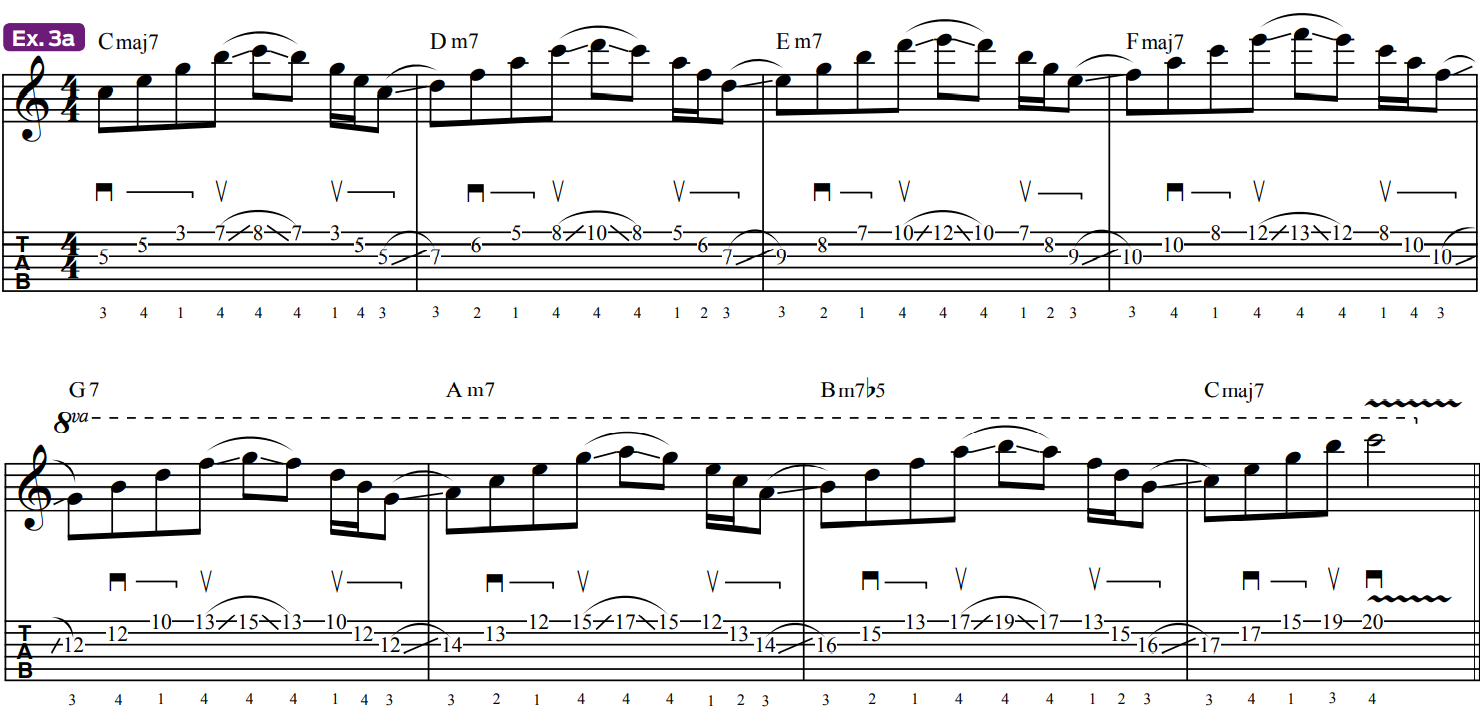
Now let’s look at some common seventh-chord sweep patterns, using the set of diatonic arpeggios based on the C major scale: Cmaj7-Dm7-Em7-Fmaj7-G7-Am7-Bm7 5. Ex. 3a is performed entirely on the top three strings and has you beginning with a downstroke sweep on the G string. Once you sweep through to the high E string, pick the seventh of the chord, the high B note, with an upstroke and slide your pinkie up to the C root note and back, then perform an upstroke sweep from the high E string to the G string, just as we did in the previous example, but in a different melodic context.
This same one-bar phrasing structure and pick-hand sequence is then applied to all the remaining arpeggios in the example, sliding up the neck to the next arpeggio shape and altering the fret-hand fingerings as needed, to accommodate the different arpeggios qualities – major seven, minor seven, dominant seven and minor seven flat-five.

Ex. 3b is performed entirely on the A, D and G strings and has us beginning with a downstroke and hammer-on from the low C root note up to the third, E, then continuing the downstroke sweep across the next two strings. You then pick the octave C root note with an upstroke, pull off back to the seventh of the arpeggio, B, and continue the upstroke sweep back across the D and A strings. This same sequence is then applied to all the remaining diatonic seventh-chord arpeggios in the key of C, again moving up the fretboard while staying on the same string group.
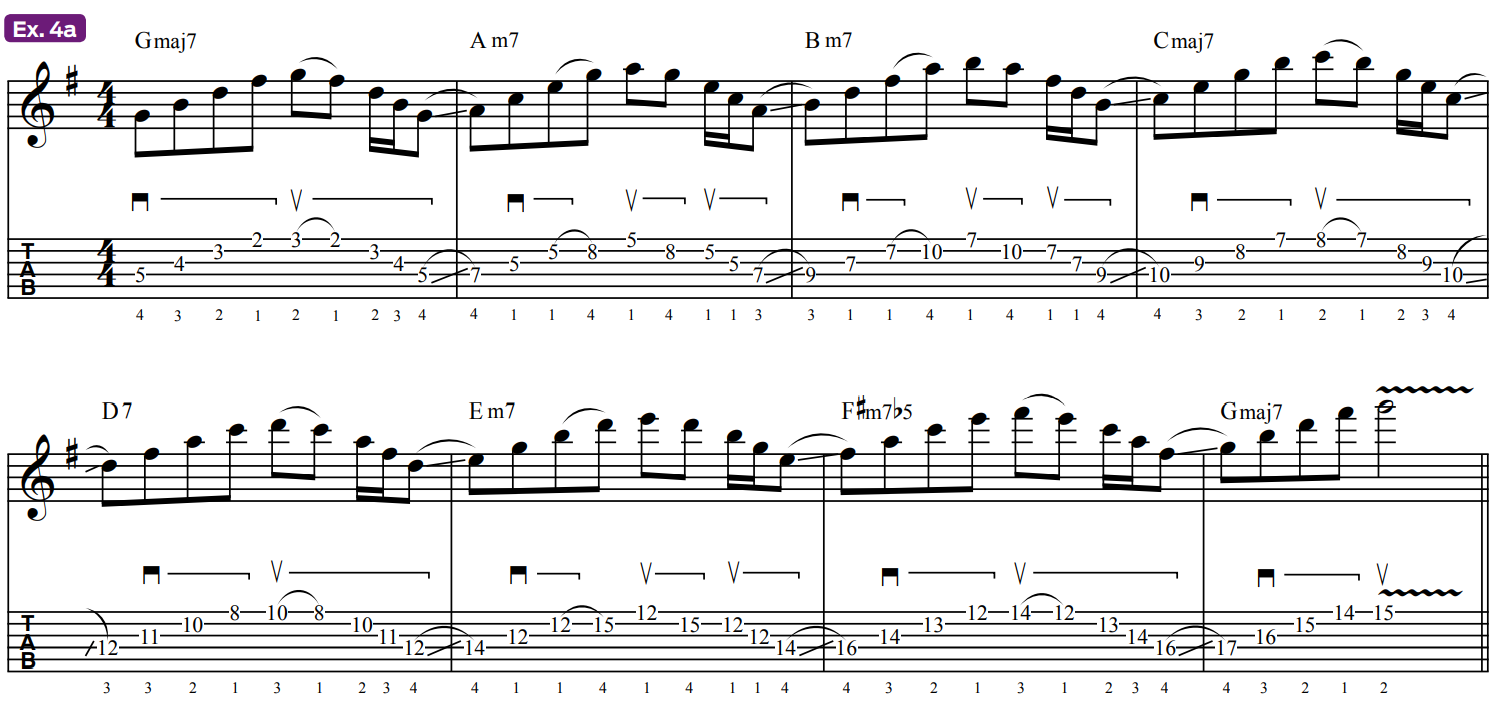
Switching to the key of G, our next two examples illustrate similar approaches applied to an arpeggiated chord scale using the G major scale’s diatonic seventh chords, first across the top four strings, then across the bottom three. In Ex. 4a, we begin with a downstroke sweep across a root-position Gmaj7 arpeggio (G B D F ) from the D string to the high E, then pick the octave G root note with an upstroke, pull off back to the seventh, F , and continue the upstroke sweep across the B, G and D strings back down to the G root.
As before, the same approach is then applied to the subsequent diatonic seventh-chord arpeggios, with a slide up to the next form and a slight alteration for the three minor sevens (Am7, Bm7 and Em7), for which we’re playing the seventh of the arpeggio on the B string instead of the high E, which affects the fret-hand fingering and sweeping structure. Pay careful attention to both the fingering and picking prompts indicated for these minor seven arpeggios, and notice in each case that, on the descent (across beats three and four), we’re doing two quick, consecutive upstrokes in a row on the B string. Alternatively, you could dispense with the second upstroke and just pull off to the note on beat four in each of these bars.
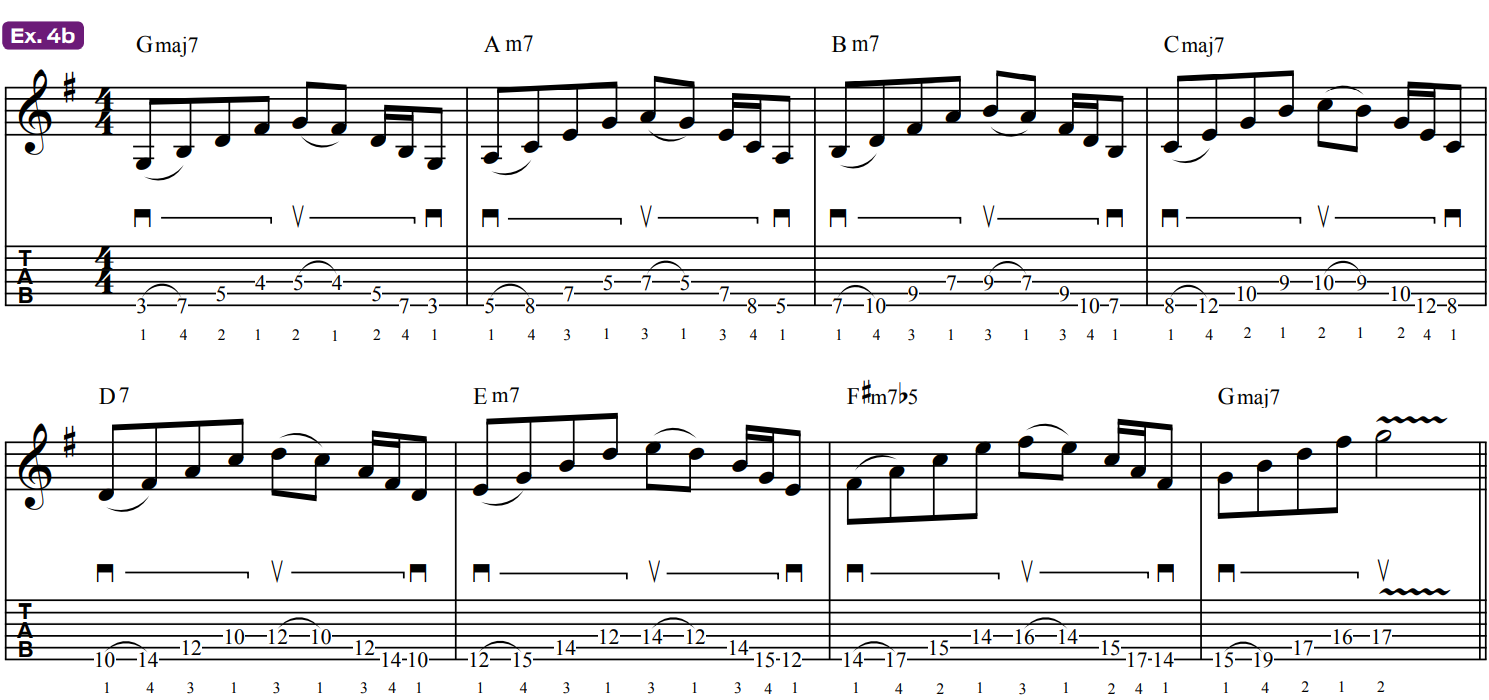
Ex. 4b is nearly identical to Ex. 3b, the only difference being that every note is played on the next lower string, a perfect fourth below. All of these arpeggio types are foundational and will come into play in the later exercises, so get to know them well!
Stacking Seventh-Chord Arpeggios
Now that you’re acquainted with the one-octave seventh-chord arpeggios shown thus far, here are some interesting ways to use them together – and make them sound like giant 10-note sweeps!

First, take a look at the four Dm7 (D F A C) arpeggio patterns shown in Ex. 5a. The first two are root-position forms (the root note being the lowest note), each of which is played in a different octave and ascends from the D root to the minor, or “flatted,” third, F, the fifth, A, and the minor, or “flatted,” seventh, C before ending on the octave D root.
In each ascending shape, begin the arpeggio with a hammer-on. After down-picking the first note, rest your pick on the next string as you perform the hammer-on and continue the downstroke sweep across the next two strings.
The two descending patterns in bar 2 work the opposite way, each starting with an upstroke followed by a pull-off and a continuation of the upstroke sweep across the next two lower strings. These arpeggios are considered second-inversion forms, as the fifth, A, is the lowest note. (They also begin on the fifth, which is highest note, too.)

Once you have these four isolated one-octave patterns down, check out the longer two-octave runs in Ex. 5b, wherein each pair of related one-octave Dm7 arpeggios is connected via a position shift, which is facilitated by a legato (unpicked) finger slide that’s used in combination with a hammer-on on the way up and a pull-off on the way down.
Since each one-octave form is in a different position, you’ll slide from one shape into the next, all the while maintaining the integrity of the sweep by only picking down through the ascending arpeggio and up through the descending arpeggio, as indicated.
Superimpositions
In rock and metal, sweep-picking patterns are typically used in a rather fundamental, straightforward way. Playing over an Am chord? Use an ascending Am sweep, then come back down on either the same Am path or a different one.
While this type of approach is all well and good, you can enrich the harmonic color of your sweep-picked lines by superimposing a different arpeggio in the upper register that’s somehow related to the underlying tonal center. For example, instead of just playing an Am arpeggio (A C E) over and Am chord, which provides the root, minor third and fifth, you could substitute Em (E G B) to get an inherently “jazzier” sound, as the notes G and B give you, relative to an A root, the minor, or “flatted,” seventh and the ninth.
Do this by starting out with your foundational triad arpeggio in the lower register, then switch to a related one as you move up the neck, using a finger slide to seamlessly transition from the base arpeggio to the superimposed one.

Ex. 6 demonstrates this concept in the guitar-friendly key of E minor. With an Em7 chord in the accompaniment (or even just Em, or an E bass note), start sweeping through a root-position Em7 arpeggio (E G B D), then slide into an inversion of it to finish out bar 1.
On the downbeat of bar 2, however, instead of playing the high E root note at the 12th fret, as expected, we instead reach up to the 14th fret F note with the pinkie and slide up a half step, to G, and back.
Now, instead of backtracking down the same Em7 path, you play a descending Gmaj7 arpeggio (G B D F#), through to the end of the phrase, creating a cool Em9 (E G B D F ) sound. This superimposition works well because there is much overlap between the two chords/arpeggios – so much, in fact, that we’re only changing one note.
Another important consideration here, however, is the phrasing. We’re starting out playing one arpeggio and ending on a different one while still playing over the same backing chord, or tonal center, and while maintaining a seamless flow of notes.
Let’s break down the music theory behind all of this: When playing over a chord that’s diatonic to whatever key you’re in – meaning all of its notes live within the key’s related scale – you have the option of superimposing any other chord that’s also diatonic, or native, to the key. This creates interplay between the chord tones of the base chord – the root, third, fifth and seventh – and the tensions availed to you by the rest of the scale – the ninth, 11th and 13th, which are the second, fourth and sixth an octave higher. So, if you’re playing anything diatonic to the key, you will therefore be playing either a chord tone or a tension, regardless of the arpeggio you’re playing.

Let’s look at another example of this superimposing-arpeggios approach, this one in the key of G (see Ex. 7). Playing over a Gmaj7 chord, we start in second position with an ascending downstroke sweep through a Gmaj9 arpeggio, which is Gmaj7 with the ninth, A, added on top as a harmonic tension.
We then slide the pinkie up to the 10th-fret D note, putting us in seventh position, then perform a descending upstroke sweep across a Cmaj7 arpeggio (C E G B), which, with the high D note, creates a Cmaj9 (C E G B D) sound.
We then slide up with the pinkie again, this time on the D string, and perform an ascending downstroke sweep through an Em arpeggio to finish the phrase. Notice how each superimposition momentarily creates and resolves harmonic tension. This is because the C and E notes are tensions, relative to the underlying Gmaj7 chord, and the rest are “agreeable” chord tones.

Most of our examples thus far have started on a downstroke sweep, so let’s change things up a bit. Ex. 8 is in the key of C and is played over a Cmaj7 chord overall, with other diatonic arpeggios superimposed.
We begin with a pull-off on the high E string, from the 12th fret to the eighth, followed by an upstroke sweep across a partial Am7 arpeggio shape, then a slide down into a G7 shape.
In bar 2, we have two consecutive downstroke sweeps across the related triadic arpeggios F and Bdim, with the high F note resolving down to E with a finger slide.
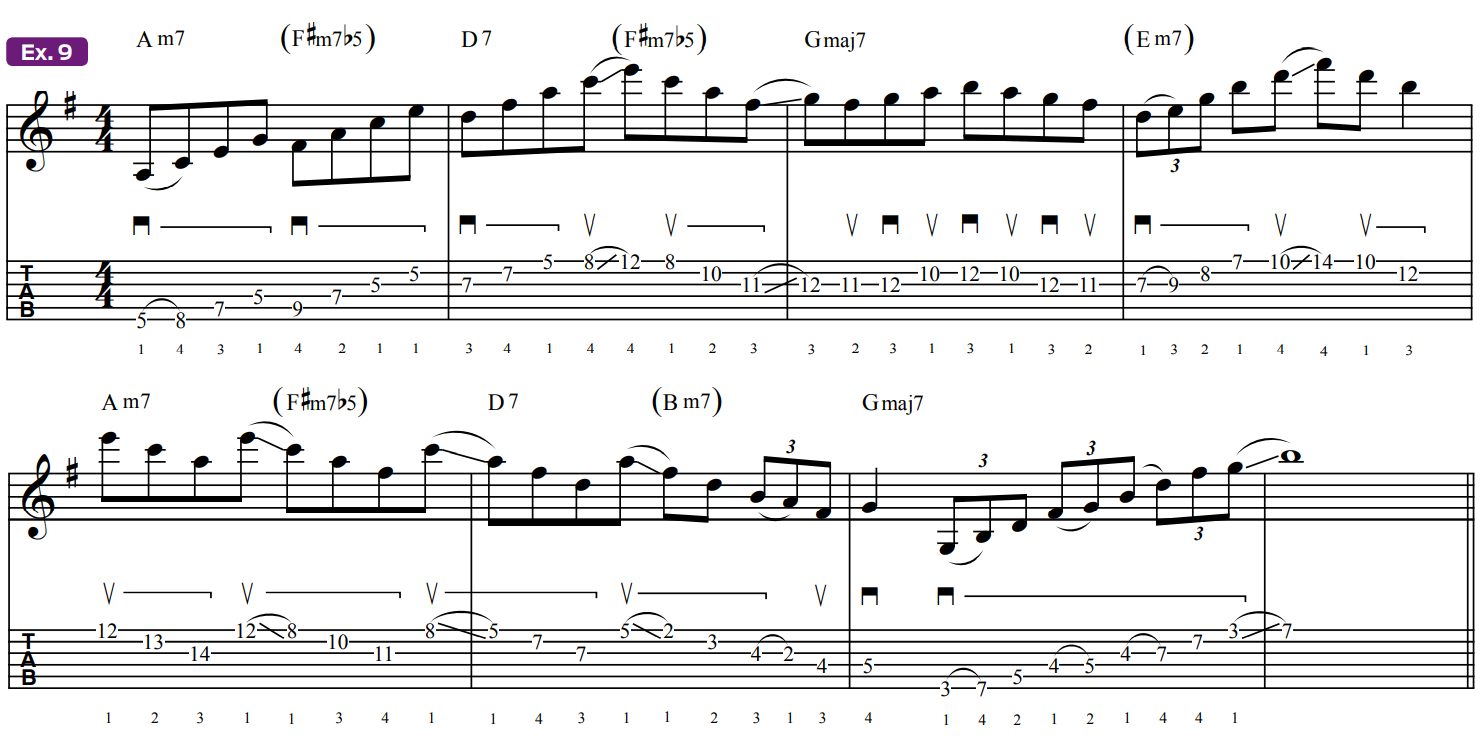
Now let’s take a look at how this arpeggio-superimposition concept can be applied to a chord progression. Ex. 9 presents an eight-bar melodic run played over a repeated ii-V-I progression in the key of G major: Am7-D7-Gmaj7.
The melody uses a combination of superimposed sweep-picked arpeggios and some that directly match the accompanying chord, plus some straight melodic playing with alternate picking over the Gmaj7 chord in bar 3, added for the sake of breaking up the pattern of successive arpeggios.
All of the chord symbols for the superimposed arpeggios are identified in parentheses to illustrate how they work in relation to the accompanying chord.
Whether you want to ditch Yngwie Malmsteen for Frank Gambale entirely or simply find new ways to change up your playing, incorporating these concepts and approaches into your melodic vocabulary will breathe new life into your sweep-picking technique and musical inventions.
